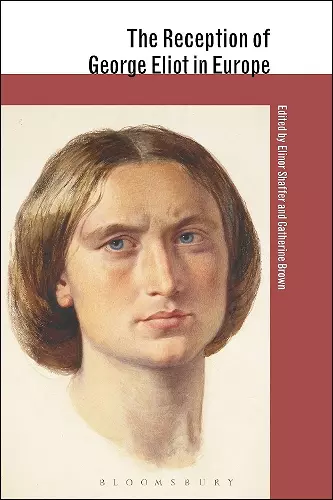The Reception of George Eliot in Europe
Dr Elinor Shaffer editor Dr Catherine Brown editor
Format:Hardback
Publisher:Bloomsbury Publishing PLC
Published:11th Feb '16
Currently unavailable, and unfortunately no date known when it will be back

Leading international scholars survey the reception of Eliot's work throughout Europe, including film and television adaptations.
George Eliot (born Mary Ann Evans, 1819-1880) was one of the most important writers of the European nineteenth century, as well as a pioneering translator of challenging and controversial Continental thinkers, and an influential editor and essayist. Although such novels of provincial life as Adam Bede, The Mill on the Floss and Middlemarch have seen her characterised as a thoroughly English writer, her reception and immersion in the literary, intellectual and political life of Europe was remarkable. Written by a team of leading international scholars, The Reception of George Eliot in Europe is the first comprehensive and systematic survey of Eliot's place in European culture. Exploring Eliot's deep knowledge of German literature and thought, her galvanizing influence on women novelists and translators in countries as diverse as Sweden and Spain, her travels in Holland, Germany, Switzerland, Austria, the Czech Lands, Italy, and Spain and her friendship with leading figures such as Mazzini, Turgenev, and Liszt, this study reveals her full stature as a cosmopolitan writer and thinker. A film of her Italian Renaissance novel Romola was one of the first to circulate in Europe.
Including an historical timeline and a comprehensive bibliography of primary and secondary sources and translations, The Reception of George Eliot in Europe is an essential reference resource for anyone working in the field of Victorian Literature or the European nineteenth century.
Begun in 2002, Bloomsbury's "The Reception of British and Irish Authors in Europe" series offers comprehensive, erudite coverage of geopolitical or translation contexts for individual authors. This volume on how George Eliot was received across hostile, friendly, or historically shifting borders over a tumultuous 150 years addresses numerous questions: Who cared that "he" was a woman? Who didn't? Who published her? Which works? When? In English or translation? How good were the translations? How many copies sold? Read in libraries? How much political, social, or literary favor or hostility appears in the texts—or the margins? The essays vary in length, depth, density, and variety of authorship, method, and style, but readers favoring a particular geography or work will find surprises. Eliot was sensitive to social stratification, so this reviewer found the essays on the shifting geopolitical contexts of Germany and former Soviet bloc countries the liveliest and most layered. Italians of course fixated on Romola—but who knew that Hollywood exploited both romantic Gish sisters, Lillian and Dorothy, to make it into a 1924 blockbuster? The volume includes a vast bibliography. Summing Up: Recommended. Upper-division undergraduates through faculty. * CHOICE *
Important sociopolitical connections emerge from the pictures of individual countries, giving the reader a broad view of not only the responses of Eliot's contemporary audience, but the far-reaching ripples of her impact over time. This combination of narrow focus on single countries, the detailed examination of Eliot's works in translation, and the high-level overview that emerges of the nineteenth-century literary landscape will be of most use to more advanced students and scholars who wish to dig deeply into Eliot's legacy and enduring relevance. * American Reference Books Annual *
An interesting account of the reception of Eliot's work across Europe ... We find much insight on Eliot's creative progress and intellectual background. * Revista de Filología Inglesa *
ISBN: 9781441190222
Dimensions: unknown
Weight: 913g
512 pages